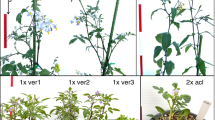Summary
The South American wild potato species Solanum commersonii Dun. exists as two subspecies, subsp. commersonii and subsp. malmeanum (Bitter) Hawkes and Hjerting, and as both diploid and triploid cytotypes. The two subspecies were completely cross fertile but there were reciprocal differences in the number of seeds set per berry and the mean seed weight. Crosses between diploids and colchicine-induced autotetraploids yielded only a few seeds per berry, but 16 of the 18 germinated seeds were triploid or nearly so. Such a high proportion of triploids is unusual for such crosses in potatoes. Some triploids has a high percentage of stainable pollen. The origin of naturally occurring triploids is discussed in the context of 2n gametes, a triploid block, and endosperm balance numbers.
Similar content being viewed by others
References
Camadro, E. L. & S. J., Peloquin, 1980. The occurrence and frequency of 2n pollen in three diploid Solanums from Northwest Argentina. Theor. Appl. Genet. 56: 11–15.
Davis, G. E., 1941. The effects of certain environmental factors on tuberization in the wild potato, Solanum commersonii. Amer, Potato J. 18: 266–269.
Dionne, L. A., 1958. 2,4-Dichlorophenoxyacetic acid as an aid to seed production when widely separated Solanum species are crossed. Nature 181: 361.
Dionne, L. A., 1965. Problems of gene exchange in tuber-bearing Solanum species. Ph.D. thesis, University of Birmingham.
Dyer, A. F., 1963. The use of lacto-propionic orcein in rapid squash methods for chromosome preparations. Stain Technol. 38: 85–90.
Hanneman, R. E.Jr. & S. J., Peloquin 1968. Ploidy levels of progeny from diploid-tetraploid crosses in the potato. Amer. Potato J. 45: 255–261.
Hawkes, J. G., 1956. A revision of the tuber-bearing Solanums. Rep. Scott. Pl. Breed. Stn. 37–109.
Hawkes, J. G., 1978. Biosystematics of the potato. In: P. M., Harris (Ed.). The potato crop. The scientific basis for improvement. Chapman and Hall Ltd., London: 15–69.
Hawkes, J. G. & J. P. Hjerting, 1969. The potatoes of Argentina Brazil, Paraguay, and Uruguay; a biosystematic study. Oxford University Press.
Jackson, M. T., P. R., Rowe & J. G., Hawkes, 1978. Crossability relationships of Andean potato varieties of three ploidy levels Euphytica 27: 541–551.
Jacobsen, P., 1957. The sex chromosomes in Humulus. Hereditas 43: 357–370.
Johnston, S. A. & R. E., HannemanJr., 1980. Support of the endosperm balance number hypothesis utilizing some tuber-bearing Solanum species. Amer. Potato J. 57: 7–14.
Johnston, S. A., T. P. M.den, Nijs, S. J., Peloquin & R. E., HannemanJr., 1980. The significance of genic balance to endosperm development in interspecific crosses. Theor. Appl. Genet. 57: 5–9.
Johnston, S. A. & R. E., HannemanJr., 1982. Manipulations of endosperm balance number overcome crossing barriers between diploid Solanum species. Science 217: 446–448.
Kessel, R. & P. R., Rowe, 1975. Production of intraspecific aneuploids in the genus Solanum. 2. Triploids produced from tetraploid-diploid crosses in potato. Euphytica 24: 379–386.
Lewis, D., 1943. The incompatibility sieve for producing polyploids. J. Genet. 45: 261–264.
Lewis, D., 1949. Incompatibility in flowering plants. Biol. Rev. 24: 472–496.
Marks, G. E., 1954. An aceto-carmine glycerol jelly for use in pollen fertility counts. Stain Technol. 29: 227.
Marks, G. E., 1958. Cytogenetic studies in Tuberous Solanum species. II. A synthesis of Solanum x vallismexici Juz. New Phytol., 57: 300–310.
Marks, G. E., 1966a. The enigma of triploid potatoes. Euphtyica 15: 285–290.
Marks, G. E., 1966b. The origin and significance of intraspecific polyploidy: Experimental evidence from Solanum chacoense. Evolution 20: 552–557.
Mok, D. W. S. & S. J., Peloquin, 1975. Three mechanisms of 2n pollen formation in diploid potatoes. Can. J. Genet. Cytol 17: 217–225.
Mok, D. W. S., S. J., Peloquin & T. R., Tarn, 1975. Cytology of potato triploids producing 2n pollen. Amer. Potato J. 52: 171–174.
Nijs, T. D. N.Den, & S. J., Peloquin, 1977. 2n gametes in potato species and their function in sexual polyploidization. Euphtyica 26: 585–600.
Okada, K. A., 1981. High frequency of triploids of Solanum microdontum subsp. gigantophyllum on the western mountain ranges of Provinces La Rioja and Catamarca, Argentina. Bull. Torrey Bot. Club. 108: 331–337.
Quinn, A. A., D. W. S., Mok & S. J., Peloquin, 1974. Distribution and significance of diplandroids among the diploid Solanums. Amer. Potato J. 51: 16–21.
Ramanna, M. S. & M. M. F., Abdalla, 1970. Fertility, late blight resistance and genome relationship in an interspecific hybrid, Solanum polytrichon Rydb. x Solanum phureja Juz. et. Buk. Euphtyica 19: 317–326.
Simmonds, N. W., 1963. Abbreviations of potato names. Eur. Potato J. 6: 186–190.
Spicer, P. B. & L. A., Dionne, 1961. Use of gibberellin to hasten germination of Solanum seed. Nature 189: 327–328.
Summers, D. & P., Grun, 1981. Reproductive isolation barriers to gene exchange between Solanum chacoense and S. commersonii (Solanaceae). Amer. J. Bot. 68: 1240–1248.
Tarn, T. R., 1967. The origin of two polyploid species of Solanum, Sect. Tuberarium. Ph. D. thesis, University of Birmingham.
Von, Wangenheim, K. H., S. J., Peloquin & R. W., Hougas, 1960. Embryological investigations on the formation of haploids in the potato (Solanum tuberosum). Z. VererbLehre 91: 391–399.
Author information
Authors and Affiliations
Rights and permissions
About this article
Cite this article
Tarn, T.R., Hawkes, J.G. Cytogenetic studies and the occurrence of triploidy in the wild potato species Solanum commersonii Dun. . Euphytica 35, 293–302 (1986). https://doi.org/10.1007/BF00028567
Received:
Issue Date:
DOI: https://doi.org/10.1007/BF00028567




